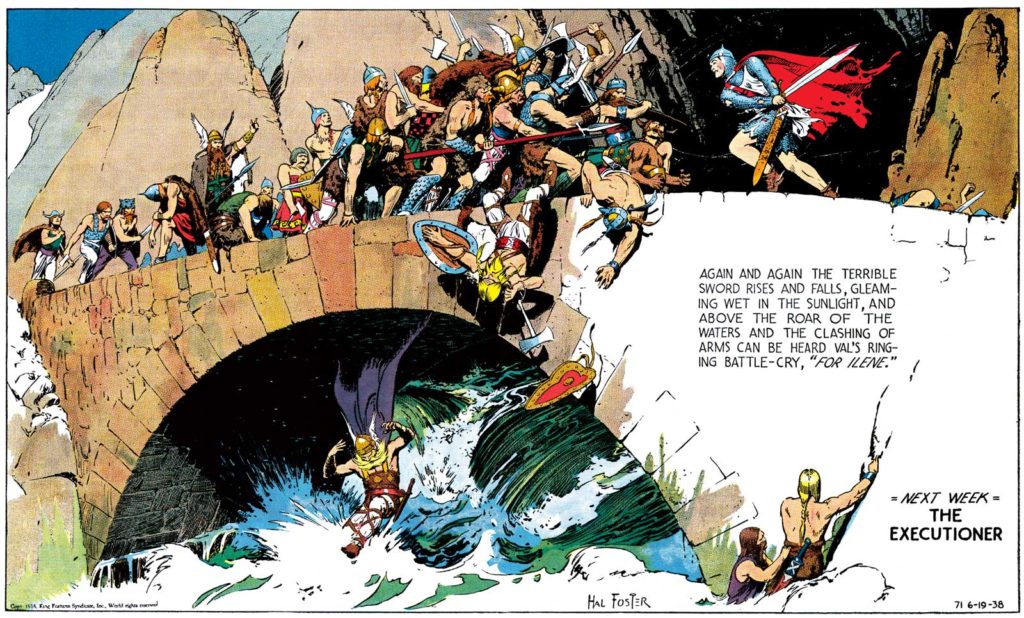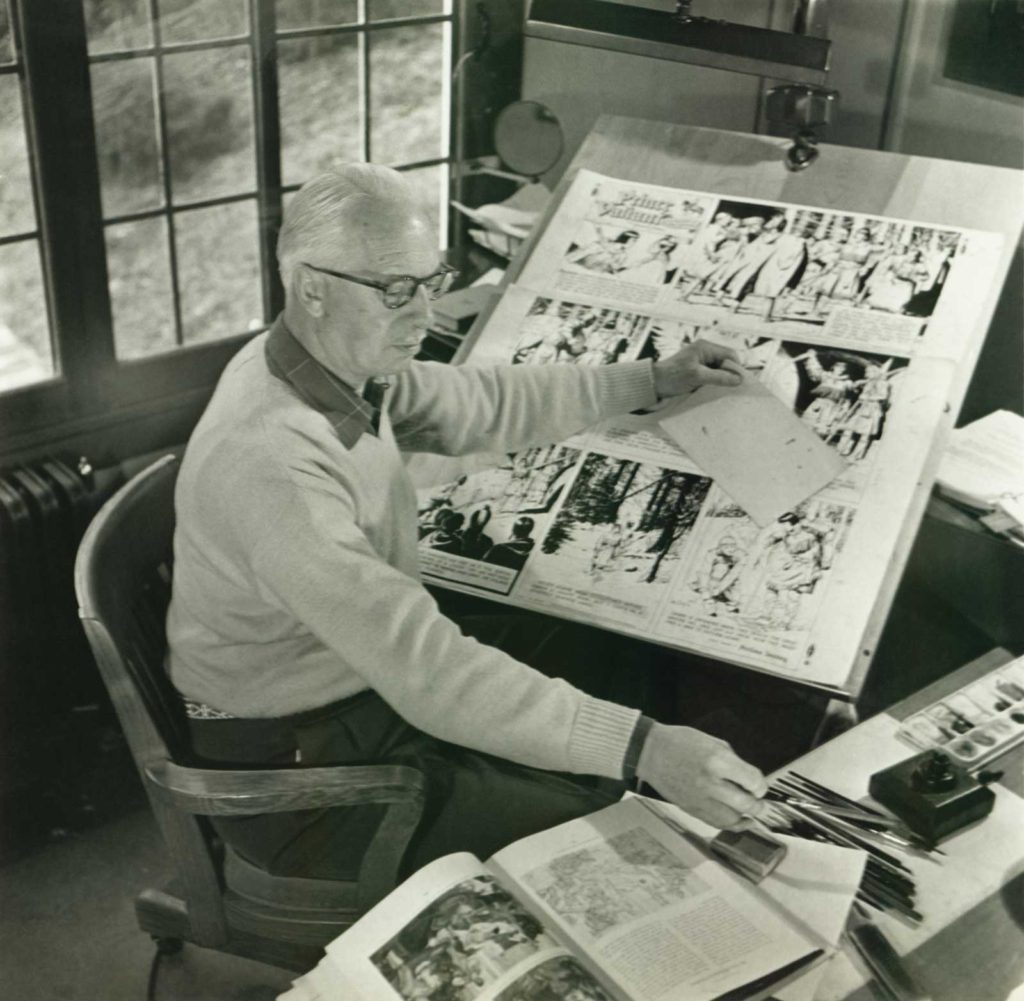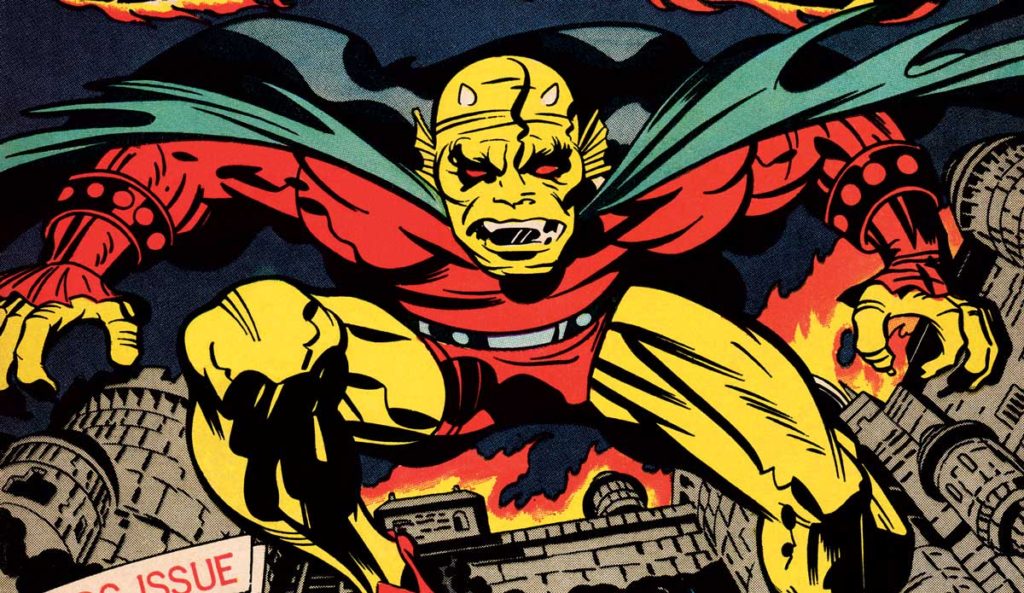While we’ve been celebrating the 40th anniversary of British comic 2000AD a lot in recent days, another comic – well, comic strip – marked its 80th anniversary earlier this month and we couldn’t let it pass by given the lasting impact and influence it had on many comic creators.
“Prince Valiant” made his debut on 13th February 1937 and here, author and editor Brian M. Kane (writer of Hal Foster: Prince of Illustrators and The Definitive Prince Valiant Companion reveals some of the strip’s history…
Before television, when most films were still black and white, the Sunday comics were an oasis of colour in a Depression-era grey world. Highly popular comic strips drove newspaper sales in the early 20th century, so it is little wonder that their creators were regarded as celebrities. The epic “Prince Valiant in the Days of King Arthur” by Harold Rudolf “Hal” Foster premiered in the many US newspapers colour comics section on 13th February 1937. Prior to “Prince Valiant”, Foster originated the adult-protagonist adventure strip genre by adapting Tarzan as a black and white daily strip in 1928, which was followed by the “Tarzan” colour Sunday feature from 1931-1937.
Faced with imposing financial and creative constraints as a work-for-hire artist, Foster focused his considerable skills as an illustrator toward producing his own strip. The extraordinary effort resulted in international prominence for both “Prince Valiant” and Foster. Today, after 80 years, “Val” remains one of the few adventure strip characters still in print.
It is difficult to imagine the impact Foster’s “Prince Valiant” had on 1930s and 1940s popular culture. When “Prince Valiant” began, Superman’s debut in Action Comics #1 was still over a year away.
Many of the first two generations of comic book creators owe a great debt to Foster. Young comic book artists studied Foster’s technique, sometimes copying panels from his strips. “Swipes” of Foster’s art can be found in the origin of Batman, and in comics drawn by Jack Kirby, the co-creator of many of today’s movie heroes, including Captain America, The Avengers, The X-Men and Thor.
Most importantly, Val epitomised a knightly moral code, creating an ethical standard of conduct that exemplified truth, justice, and what it meant to be a hero.
Seminal works such as The Hobbit, The Sword in the Stone and The Chronicles of Narnia had yet to be published in February 1937. By the time Joseph Campbell’s groundbreaking The Hero with a Thousand Faces was published in 1949, “Prince Valiant” had already spent 12 years on his own monomythic hero’s journey. Yet, unlike in Campbell, Val’s adventures included strong, self-reliant, heroic women, attesting to Hal’s wife Helen’s influence on the strip.
For the uninitiated: Valiant, a lowly Prince of Thule, fell in love with and eventually married Aleta, Queen of the Misty Isles. To Hal’s and Helen’s credit, Aleta became a role model for the millions of capable women running America during World War II, fighting off offenders with her wit, charm, intelligence and, on occasion, a hidden dagger strapped to her thigh. Aleta was kicking butt long before Princess Leia, Katniss Everdeen or most of the Disney princesses were even a thought.
Though set in the time of King Arthur, Foster’s “Prince Valiant” was surprisingly contemporary. During World War Two, Val fought the Huns, resulting in the strip being cancelled in German newspapers. In 1943, Val befriended a boy with a withered leg who could not “play soldier” with the other boys. Nevertheless, the boy was encouraged to hone his skills so that one day he could be “arrow-maker to King Arthur.” The story appeared a year into a polio epidemic and 16 months after Pearl Harbor, and was a call to service to all who could not go off to fight.
After the war, as American troops returned home, Val and Aleta sailed to the “New World” and had a son, heralding the coming baby boom. Then, as the demographics of 1950s America changed, multi- cultural couples in Prince Valiant married and had children just as they did in the popular sitcom I Love Lucy.
Foster’s “Prince Valiant” is not just an adventure, or romance, or humour strip — though it is sprinkled with all those elements. “Prince Valiant” is a graphic novel about life, where people fall in love, wars are fought, children are born and grow older, hearts are broken, friends die in battle, couples marry, and even disfigured and disabled characters young and old, male and female, have a place and purpose in this brave world Foster fashioned.
While some may feel “Prince Valiant” is archaic by today’s standards, perhaps its unabashedly inclusive “Might for Right” message is simply ahead of its time.
Long live Val!
Brian M. Kane, Ph.D., is the author of the IPPY Award-winning biography Hal Foster: Prince of Illustrators , and edits the New York Times Best-Selling Prince Valiant reprint series from Fantagraphics Books.
Article courtesy King Features Prince Valiant © King Features Syndicate, Inc. 2017
The founder of downthetubes, which he established in 1998. John works as a comics and magazine editor, writer, and on promotional work for the Lakes International Comic Art Festival. He is currently editor of Star Trek Explorer, published by Titan – his third tour of duty on the title originally titled Star Trek Magazine.
Working in British comics publishing since the 1980s, his credits include editor of titles such as Doctor Who Magazine, Babylon 5 Magazine, and more. He also edited the comics anthology STRIP Magazine and edited several audio comics for ROK Comics. He has also edited several comic collections, including volumes of “Charley’s War” and “Dan Dare”.
He’s the writer of “Pilgrim: Secrets and Lies” for B7 Comics; “Crucible”, a creator-owned project with 2000AD artist Smuzz; and “Death Duty” and “Skow Dogs” with Dave Hailwood.
Categories: British Comics - Newspaper Strips, downthetubes Comics News, downthetubes News











 British creators Liam Sharp, Richard Starkings and Bryan Talbot, among 2024 Eisner Award nominees
British creators Liam Sharp, Richard Starkings and Bryan Talbot, among 2024 Eisner Award nominees  Rare early Giles collection offered in eBay charity auction, yours for £200 – and counting!
Rare early Giles collection offered in eBay charity auction, yours for £200 – and counting!  Can you help bring new “Matt Marriott” collections to print?
Can you help bring new “Matt Marriott” collections to print?  Thunderbirds newspaper strip rarity drawn by Don Lawrence offered at auction, bids close today
Thunderbirds newspaper strip rarity drawn by Don Lawrence offered at auction, bids close today